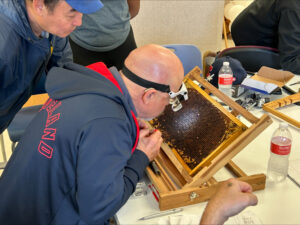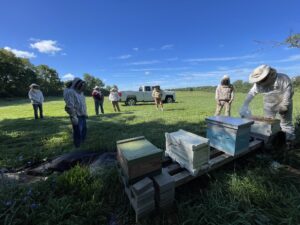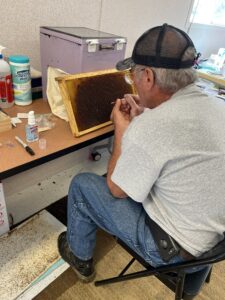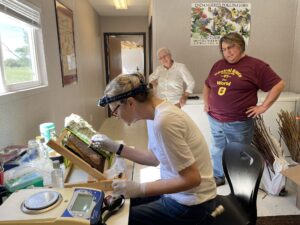Progress report for LNC21-459
Project Information
Wild feral honeybee colonies are one of the best local resources for improving the genetic diversity of honeybees. It is important to educate bee farmers about queen rearing and utilize local resources for sustainable apiculture instead of importing thousands of packages of bees with pathogens and parasites in the United States. The quality of the queen of a honeybee colony is essential for survival. Based on our data, feral queens tend to live longer than commercial queens. We hypothesized that feral queens may tolerate oxidative stress by living longer.
By comparing feral stocks with commercial package colonies, the aims listed below will be achieved:
1) to reveal the quality of flight ability and mating ability, we will compare the flight abilities of virgin queens using flight mills in the lab;
2) to analyze levels of oxidative stress of queen pupae using physiological assays;
3) to reveal the difference in the population, we aim to investigate the genetic variation among different queens, worker, and drones via single-cell sequencing technology with the best accuracy;
4) to educate bee farmers on queen rearing and grafting, the Central State University Research and Extension programs provide hands-on workshops in 2023 and 2024 and customized classes (webinars and field day) on queen grafting, genetic diversity, and queen disease;
5) to work with Purdue University (1862 Land-Grant Institution) and regional queen breeders to select mite biters, and
6) to train minority students on pollinator health and agricultural research. We work with beekeepers and queen breeders from eight different states (OH, IN, IL, MI, WI, WV, KY, and PA.) for queen breeding efforts.
CSU agricultural and natural resources extension supports farmers in using feral bees with high grooming & mite biting behavior. This research and education program provided by an HBCU and 1890 Land-Grant Institution will improve the genetic diversity of honeybees significantly for the North Central Region. By using local resources of feral colonies, we aim to improve environmental quality by reducing the risks of new pathogens and parasites from importing honey bee colonies to Ohio.
Our objectives/outcomes are:
1) test the flight abilities of virgin queens to achieve the outcome of the knowledge in the flight ability;
2) analyze levels of oxidative stress of queen pupae;
3) identify new transcriptomic variation among different castes;
4) to provide field days and work with regional queen breeders on instrumental inseminations and breeding for mite-resistant/mite-biter stocks;
5) to organize hands-on workshops and field days for local beekeepers to learn about grafting and queen rearing; and,
6) to train under-represented minority students on apiculture, pollinator health, honeybee genetics, and breeding.
Honeybees are the most important managed pollinators, contributing $15 billion to the US economy. However, managed bee colonies are in a 60% annual decline in Ohio. The ectoparasitic mite Varroa destructor has been the most severe factor for disease and weakness of the colonies since 1987. Promoting mite-resistant bees is one of the most effective ways to mitigate the bee decline. We have a collection of bee stocks from feral colonies that are mite-resistant. However, the limiting factor for local honeybee resources is fewer queens and nuclei available to fulfill the demand of beekeepers in the region. Working with experienced queen producers, we will investigate how to improve the queen quality of honeybee stocks. Our research aims to study the flight abilities of virgin queens, levels of oxidative stress of queen pupae, differentially expressed genes between queen and workers using single-cell sequencing technology, and providing hands-on field workshops and training for beekeepers and bee farmers on queen rearing, grafting, and, work with regional queen breeders on instrumental inseminations and breeding for mite-resistant/mite-biter stocks. Students at Central State University, as first-generation college students or from low-income families, are trained on apiculture, pollinator health, honeybee genetics, and breeding.
Cooperators
Research
Queen bees from high grooming stocks have a set of genetic markers for selection, and different levels of oxidative stress and flight abilities compared to low grooming or commerical stocks.
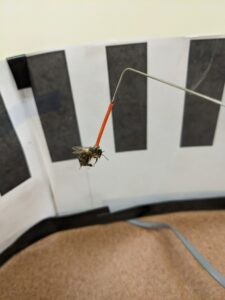
For outcome 1, we ask whether feral queens have better flight ability than the commercial package bees. Our lab has developed a protocol and a scientific publication for the method (Ma et al., 2019). Virgin queens will be evaluated using flight mills (Figure 1). As the glued bees on the mill, a computer connected to the flight mill sensor recorded maximum and mean velocity, flight duration, and flight distance. At least six virgin queens from each treatment (feral or commercial) will be used and each queen will be tested for six separate trial days. Feral stocks are from our university apiary. The non-selected commercial colonies are from GA and FL as controls. All flight mills will be located in the same room, with constant light (546.2±1.0 lx) and air temperature (25±1 ∘C). Six virgin queens per treatment group (feral queen vs commercial queen) will be used in this experiment.
For outcome 2, we ask whether the level of oxidative stress in feral queens is higher than the commercial bees. Queen pupae will be produced by our lab by grafting from two treatments (feral vs commercial) and collected for tests. Reactive Oxygen Species (ROS)- mediated oxidative damage will be quantified by measuring the Malondialdehyde (MDA) level in individual queen pupae (Li-Byarlay et al., 2016, Simone-Finstrom et al., 2016, Li-Byarlay & Cleare, 2020). The assay will be conducted using the OXItek™ Thiobarbituric Acid Reactive Substances (TBARS) Assay Kit (ZeptoMetrix Corp). The Pierce™ BCA™ Protein Assay kits (Thermo Scientific) will be used to measure the total soluble protein. Oxidative damage by normalized MDA levels will be examined in three biological replicates (colony). Each colony type (feral or package) includes at least six individual queen pupae (red-eye stage). Data will be analyzed using ANOVA.
For outcome 3, we ask whether we can identify new genetic markers for queen quality using cutting-edge technology. For whole genome amplification (WGA), we will use the Primary Template-directed Amplification (PTA) (Gonzalez et al., 2020). We plan to use twelve samples, six fertilized eggs (high mite biting stock versus non-selected commercial bees), and six samples of semen for instrumental insemination from two populations, prepare single-cell sequencing libraries by the 10x Genomics Chromium controller (Traniello et al., 2020). Downstream Illumina sequencing will be carried out at Ohio State University Sequencing center.
For outcome 4, we ask whether we can change more bee farmers on their view of local bee resources, sustainable queen rearing in Ohio. We aim to have a three-day workshop with about 33 participants each year on how to do grafting and queen rearing, how to make swarm traps and catch local feral stocks, and how to detect mite biting behavior traits using microscopes. Participating/trained bee farmers will receive a certification from Central State University.
For outcome 5, we plan to hold 4-5 day long field days with Purdue University and HHBBC each year on instrumental insemination events and work with queen breeders in the North Central Region to promote regional efforts on breeding for mite biters and mite resistant stocks. The field day event will be normally in May each year depending on drone and queen availabilities. Breeders will exchange genetics of queens from different feral colonies with high biting or chewing rate. Queen breeders will collect semen, conduct instrumental inseminations, and meet to discuss how to improve the breeding efforts as a group for our region.
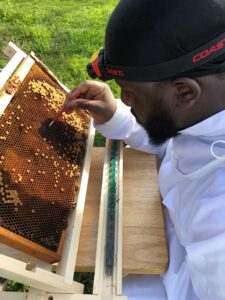
For outcome 6, we ask whether we can train more undergraduate students on honeybee genetics, genomics, physiology, and pollinator health. At least six students of the under-represented minority will be trained on the lab protocols to perform experiments of flight mill experiments, TBARS assays, and sequencing experiments. They will be the future workforce for sustainable apicultural and agricultural research. Figures 3 and 4 show examples of our student training for research. We have trained 13 African American college students (7 females) in the past three years.
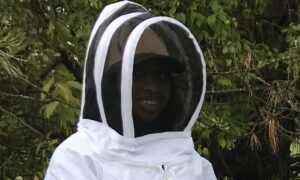
All the data and research results will be shared by research & extension publications, newsletters to the Ohio State Beekeepers Association, CSU extension and outreach activities (American Beekeeping Federation, State of Ohio State Fair, Farm Science Review, Ohio Ecological Food and Farm Association Conference, Black Farmer Conference, Minority and Women Small Farmers Conference, and local agricultural or farmer conferences).
Reference
Gonzalez, V., Natarajan, S., Xia, Y., Klein, D., Carter, R., Pang, Y., Shaner, B., Annu, K., Putnam, D., Chen, W., Connelly, J., Pruett-Miller, S., Chen, X., Easton, J. and Gawad, C. (2020) Accurate Genomic Variant Detection in Single Cells with Primary Template-Directed Amplification. bioRxiv, 2020.11.20.391961.
Li-Byarlay, H., Huang, M.H., Simone-Finstrom, M., Strand, M.K., Tarpy, D.R. and Rueppell, O. (2016) Honey bee (Apis mellifera) drones survive oxidative stress due to increased tolerance instead of avoidance or repair of oxidative damage. Experimental Gerontology.
Li-Byarlay, H. and Cleare, X.L. (2020) Current trends in the oxidative stress and ageing of social hymenopterans. Advances in Insect Physiology, 59, 43.
Ma, C., Zhang, Y., Sun, J., Imran, M., Yang, H., Wu, J., Zou, Y., Li-Byarlay, H. and Luo, S. (2019) Impact of acute oral exposure to thiamethoxam on the homing, flight, learning acquisition and short-term retention of Apis cerana. Pest Management Science, 75, 2975-2980.
Simone-Finstrom, M., Li-Byarlay, H., Huang, M.H., Strand, M.K., Rueppell, O. and Tarpy, D.R. (2016) Migratory management and environmental conditions affect lifespan and oxidative stress in honey bees. Scientific Reports, 6.
Traniello, I.M., Bukhari, S.A., Kevill, J., Ahmed, A.C., Hamilton, A.R., Naeger, N.L., Schroeder, D.C. and Robinson, G.E. (2020) Meta-analysis of honey bee neurogenomic response links Deformed wing virus type A to precocious behavioral maturation. Scientific reports, 10, 1-12.
Regarding the objective 1 on the flight ability, for the year of 2022, we have started the grant as the first year. As to the objectives/outcomes, we have worked on establishing a protocol to test the flight abilities of virgin queens, hired a postdoctoral researcher to work on the genomic variations of queens for breeding; provided a field day with regional queen breeders on instrumental inseminations and breeding for mite-resistant/mite-biter stocks; organized hands-on workshop and field day for local beekeepers to learn about grafting and queen rearing; and trained 2 CSU students on apiculture, pollinator health, honeybee genetics, and breeding.
For the year of 2023, we have established a lab protocol for the flight ability experiments, and equipped with 6 flight mills in the molecular lab and 4 mills in our field lab. As to Objective 1, CSU Student Kristan Major has established a protocol for testing fly abilities of virgin queens. The comparison is between virgin queens handled before instrumental insemination (II) and after II.
|
Group |
Distance |
Total Time |
Halt Time |
Flying Time |
Mean Velocity |
Velocity Max |
|
Non-Inseminated Queen |
90.1637m |
340.814s |
13.128s (4) |
327.686s |
0.13793m/s |
0.521 |
|
Inseminated Queen |
63.7743m |
481.898s |
38.467s (3) |
443.431s |
0.14314m/s |
0.44248 |
She also collected data and tested 6 queen bees between high and low biting colonies of CSU stocks.
|
Group |
Distance |
Total Time |
Halt Time |
Flying Time |
Mean Velocity |
Velocity Max |
|
Low Biting Queen |
240.332m |
580.295s |
33.385s |
546.91s |
0.40193m/s |
0.45073 |
|
High Biting Queen |
12.8805m |
339.263s |
559.036s |
-219.773s |
0.09349m/s |
0.45663 |
|
Group |
Distance |
Total Time |
Halt Time |
Flying Time |
Mean Velocity |
Velocity Max |
|
Low Biting Workers (Trial 1) |
119.381m |
5359.04s |
37597s |
-32238s |
0.22658m/s |
0.44624 |
|
High Biting Workers (Trial 1) |
140.743m |
51.5s |
77964.8s |
-77913.3s |
0.35666m/s |
0.77757 |
|
Low Biting Workers (Trial 2) |
878.215m |
85215.7s |
483.591s |
84732.1s |
0.30881m/s |
0.67273 |
|
High Biting Worker (Trial 2) |
530.615m |
11676.5s |
3814.92 |
7861.54s |
0.27799m/s |
0.81178 |
For the year of 2024 summer, CSU student Laverne Ambrister was able to collect worker bees from both high and low grooming colonies, and worked on the comparison of flight abilities between the two stocks. Student has presented her summer research at our lab's Research Symposium in July 2024. The slides with data are attached here.
Laverne Ambrister Research Presentation 2024 summer
We did face challenges of low number of worker bees available for the testing. In the summer of 2025, student will optimize the protocol more, and aim to collect more queen bees from both high and low grooming colonies to compare their flight ability and their oxidative stress for objective 2.
for Objective 3, we modified the goal to study the gene expression and genomic difference among different reproductive castes, including the queen (reproductive), worker (non-reproductive), and drone (reproductive) castes by using the spatial transcriptomics and single cell-seq technologies.
Bees:
We used three distinct A. mellifera colonies as biological control: H119, H148 and H156. Each one contained two deep hive boxes. Each box contained 8 frame of bees. These colonies were managed at the Central State University campus by State Road 42 in Xenia, Ohio. Two workers and two drones, and two sister queens were collected. Workers and drones were directly collected from the hive. For queens, neonates within 3 days old were grafted into queen cups and placed in a queenless cell builder, which consists of workers from the same colony. Before adult queens were hatched, the queen cells were transferred to individual queen cages and were continued to be raised in the queenless hive for the experiment.
Brain dissections and cell disassociation:
The brain dissection and cell disassociation were followed by the revised protocol (supplementary 1). Brains of two individuals from the same caste of same hive were pooled to increase the number of cells. To minimize the cell mortality, the brains were dissected at 4 °C walk-in chamber and immediately proceeded to cell disassociation.
Library construction and sequencing:
To maximize the number of cell being analyzed, we used all the disassociated brain cells from 2 brains to construct 10X single cell library. 3’ Single cell RNA-seq libraries were prepared using Chromium Next GEM Automated workflow (10X Genomics). The prepared libraries went through quality control (QC) procedures and sequenced at Singulomics using Illumina NovaSeq X Plus platform.
Data analysis:
The software Cell Ranger (version 8.0.1) was adopted for analyzing 10X single cell data. Sequences underwent a series of quality control and filtering process and aligned to A. mellifera reference genome (Amel_Hav3.1). Cell counting and unique molecular identifier (UMI) counting were performed to determine cell and gene expression profile within each cell. Then cells were clustered into categories based on the similarity of gene expression profiles.
Progresses and Results:
Library construction:
A total of 9 libraries were constructed from pooled 2 brains of each group (Table 1).
Table 1. Brain single-cell libraries
|
Sample Name |
Colony |
Caste |
i7 Index |
i5 index |
Load volume (ul) |
cDNA mid QC (pg/ul) |
Library concentration (ng/ul) |
|
H148Q |
Hive 148 |
Queen |
ATGGCTTGTG |
GAATGTTGTG |
32 |
3220 |
17.2 |
|
H148D |
Hive 148 |
Drone |
TCTTACTTGC |
TGACCTCTAG |
32 |
846 |
12.7 |
|
H148W |
Hive 148 |
Worker |
CGTCAAGGGC |
TAGGTCACTC |
32 |
2620 |
11.7 |
|
H119Q |
Hive 119 |
Queen |
TTCTCGATGA |
TGTCGGGCAC |
32 |
3590 |
17.9 |
|
H119D |
Hive 119 |
Drone |
TCCGTTGGAT |
ACGTTCTCGC |
32 |
912 |
31.7 |
|
H119W |
Hive 119 |
Worker |
ACGACTACCA |
ACGACCCTAA |
32 |
4250 |
22 |
|
H156Q |
Hive 156 |
Queen |
AGAATGGTTT |
GAGGGTGGGA |
32 |
2170 |
51.2 |
|
H156D |
Hive 156 |
Drone |
ATGGGTGAAA |
CTTGGGAATT |
32 |
2460 |
61.4 |
|
H156W |
Hive 156 |
Worker |
TCGTCAAGAT |
GCAACTCAGG |
32 |
3070 |
16.3 |
Sequencing:
NovaSeq X Plus platform provided sequencing with deep sequence depth. About 300 – 450 million reads were generated (Table 2).
Table 2. Sequencing depth of each single-cell RNA-Seq library
|
Sample |
Number of Reads |
|
H148Q |
315,626,297 |
|
H148D |
340,892,933 |
|
H148W |
337,192,257 |
|
H119Q |
288,232,877 |
|
H119D |
430,845,989 |
|
H119W |
373,787,953 |
|
H156Q |
330,185,359 |
|
H156D |
406,436,566 |
|
H156W |
421,692,134 |
Reads alignment, cell and UNI counting and cell clustering
Sequencing reads from all libraries report high rate of mapping to A. mellifera reference genome. The overall mapping rates are between 84.20% and 96.30%. The majority of confidently aligned reads were mapped to exons, while a small portion were aligned to introns and intergenic regions. There are 2-10% Reads were mapped to antisense strands, suggesting RNAi regulation mechanisms were taken place for those genes (Table 3).
Table 3. The alignment result of single cell RNA-Seq sequencing reads
|
Sample |
Mapped to Genome |
Mapped Confidently to Genome |
Mapped Confidently to Intergenic Regions |
Mapped Confidently to Intronic Regions |
Mapped Confidently to Exonic Regions |
Mapped Confidently to Transcriptome |
Reads Mapped Antisense to Gene |
|
H148Q |
90.40% |
77.30% |
9.50% |
16.10% |
51.70% |
63.60% |
4.10% |
|
H148D |
88.80% |
75.60% |
8.40% |
10.30% |
56.90% |
63.90% |
3.20% |
|
H148W |
95.10% |
76.20% |
9.80% |
15.60% |
50.80% |
61.50% |
4.70% |
|
H119Q |
84.20% |
74.40% |
10.50% |
15.90% |
48.00% |
58.40% |
5.30% |
|
H119D |
90.50% |
84.90% |
9.80% |
8.90% |
66.20% |
71.40% |
3.60% |
|
H119W |
91.70% |
86.50% |
11.70% |
18.60% |
56.20% |
69.60% |
5.10% |
|
H156Q |
95.00% |
73.00% |
12.50% |
13.80% |
46.70% |
51.10% |
9.40% |
|
H156D |
95.40% |
92.30% |
6.40% |
2.50% |
83.30% |
83.50% |
2.30% |
|
H156W |
96.30% |
93.40% |
7.60% |
7.20% |
78.60% |
82.80% |
3.00% |
All the samples showed similar total number of gene detected, suggesting that the same set of genes were expressed regardless the differences of colony and caste. The number of living cell called from CellRanger varies from 2,000 (H148W) to 81,695 (H119D). Cells from each sample show gene number median from 228 to 1661 and RNA molecule from 4,228 to 152,992. This is probably due to the variation among samples during sample and library preparations It is predicted that sample with less viable cell tend to show lower number of cell and more genes and molecules within each cell.
Table 4. Cell and UMI counting results for each sample
|
Sample |
Estimated Number of Cells |
Mean Reads per Cell |
Median Genes per Cell |
Valid Barcodes |
Sequencing Saturation |
Total Genes Detected |
Median UMI Counts per Cell |
|
H148Q |
23,669 |
13,335 |
1,626 |
97.10% |
31.40% |
11,826 |
3,675 |
|
H148D |
32,593 |
10,459 |
681 |
96.80% |
47.90% |
11,812 |
2,270 |
|
H148W |
2,205 |
152,922 |
1,661 |
96.30% |
83.00% |
11,548 |
8,158 |
|
H119Q |
68,165 |
4,228 |
556 |
96.40% |
30.30% |
11,839 |
1,189 |
|
H119D |
81,695 |
5,274 |
342 |
98.10% |
50.50% |
11,732 |
1,602 |
|
H119W |
69,287 |
5,395 |
589 |
97.80% |
46.10% |
11,860 |
1,380 |
|
H156Q |
17,913 |
18,433 |
876 |
96.40% |
77.00% |
11,736 |
1,829 |
|
H156D |
51,514 |
7,890 |
228 |
98.40% |
42.70% |
11,407 |
3,568 |
|
H156W |
63,251 |
6,667 |
273 |
98.20% |
52.80% |
11,659 |
2,209 |
Based on the similarity of expression profile, the cells of each sample can be clustered into several groups. Our data demonstrates except two samples shows low number of clusters are likely due to the low number of cell count. Other presented 14-23 clusters, based on the algorithm.
Table 5. Number of cluster claimed by Cell Ranger, based on expression profile similarity
|
Sample |
# of Cluster |
|
H119D |
21 |
|
H119Q |
23 |
|
H119W |
23 |
|
H148D |
14 |
|
H148Q |
23 |
|
H148W |
5 |
|
H156D |
18 |
|
H156Q |
7 |
|
H156W |
19 |
For Objective 4, we have successfully organized three queen workshops for beekeepers from Ohio and nearby regions in June 22nd, 24th, August 11th-12th 2022, May 25th -26th, 2023, and May 16th -17th, 2024. We changed bee farmers on their view of local bee resources, sustainable queen rearing in Ohio. Two-day hands on workshop with about 20 participants each year on how to do grafting and queen rearing, how to make swarm traps and catch local feral stocks, and how to detect mite biting behavior traits using microscopes. Participating/trained bee farmers took quizzes, and with a grade of 80% or high, they had received certifications from Central State University. The picture on the left was our successful workshop from 2024.
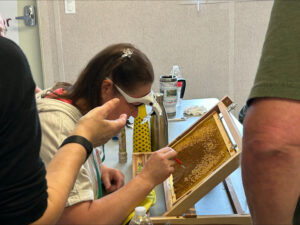
Feedback and survey from participants are attached here, showing that 93% of participants are satisfied or very satisfied with our workshop.
Post-Survey summary data 2024 Pre-Survey morecommnents 2024
For objective 5, we held 5 day long field days with Heartland Honey Bee Breeding Coop (HHBBC) and Kentucky Queen Bee Breeding Association (KQBBA) in May 30-June 3rd 2022, June 1st -6th 2023, May 27th - 31st, 2024 on instrumental insemination events and worked with queen breeders in the North Central Region to promote regional efforts on breeding for mite biters and mite resistant stocks. Breeders exchanged genetics of queens from different feral colonies with high biting rate. Queen breeders collected bee semen from CSU high biting stocks, conducted instrumental inseminations, and met to discuss how to improve the breeding efforts as a group.
For objective 6, we have trained 5 undergraduate students (K Clark, C Woods, K Major, L Ambrister, K. Briscoe) on honeybee genetics, genomics, physiology, and pollinator health. They were trained on the lab protocols to perform experiments of flight mill experiments, TBARS assays, preparing DNA and RNA molecular samples for sequencing experiments. They career goals are in sustainable apicultural and agricultural research.
We conducted single-cell RNA-Seq experiments on the brain tissue of three different social castes of the honeybee: queen, drone, and worker. Three distinct colonies were incorporated as biological replications. The results show large variations among samples. Potential technical difficulties include the following aspects: (1) Dissection lag. Each sample requires about 20 minutes to dissect. Usually, samples from one biological replication should be dissected together. Thus, when the last sample is done, there is a minimum of 40 minutes difference between the first and the last sample. The effect of extra incubation in buffer on ice should be further studied. (2) Variation during the 10X Chromium Connect run. We assumed that the Chromium Connect run itself, and the temperature difference within and outside of the instrument may cause variations in the run. (3) The Illumina Nova-seq pipeline needs to be adjusted to meet the need of UMI-based sequencing and to reduce the bias.
We have presented the descriptive analysis of the sequencing result of 9 single-cell RNA-Seq libraries. Further steps include: (1) find the association of cell clusters claimed by Cell Ranger with the anatomical structure and functional cell groups; (2) compare the correlation among the clusters from queen, worker and drone. The knowledge obtained in these studies will contribute to understanding the role of cell groups in honeybee sex determination, caste differentiation, and differences in behavior of castes.
Education
Project Activities
Educational & Outreach Activities
Participation summary:
2/15/2023 New insights into the grooming and biting behavior of honey bees from the mandible transcriptomics, Kentucky Queen breeding Association workshop, invited talk;
1/18/2023 Genetics and Breeding of Mite-Resistant Honey Bees Stocks in Ohio and the Midwest, Central Ohio Beekeeper Association invited talk;
11/13/2022 Testing new physical control on Varroa mites in honeybee colonies Joint ESA/ESC/ESBC annual meeting Vancouver, Canada;
10/1/2022 How Do I Become a Bee Scientist: the ABCs and XYZs of Women Doing Bee Science, Bee Culture Conference, Medina, OH, invited talk;
4/25/2022 Mandibles from mite-biting bees: a multifaceted approach, Entomological Society of Ameria International Branch symposium virtual;
4/25/2022 Differences in Varroa Mite size: Feral vs Commercial Honeybees, Entomological Society of Ameria International Branch symposium virtual;
6/24/2022 CSU queen rearing workshop at CSU,
5/31/2022 Queen insemination field day, CSU campus, with Heartland honey bee breeding coop and Kentucky Queen Bee Breeding Association.
Learning Outcomes
Project Outcomes
Bee farmers and beekeepers in Ohio learned how to do grating and queen rearing using local resources
Bee farmers and beekeepers in Ohio learned about the basic principles on how to do queen breeding
Bee farmers and beekeepers in Ohio learned how to make queen cell starter and finisher colonies.
Bee farmers and beekeepers in Ohio are educated on honeybee genetics, behavior, queen bee genetics and biology.
testimony of beekeepers bobbie oct 2023
Maybe it will be good to receive news from you on other projects related to honeybees, pollinators, or beneficial insects.
